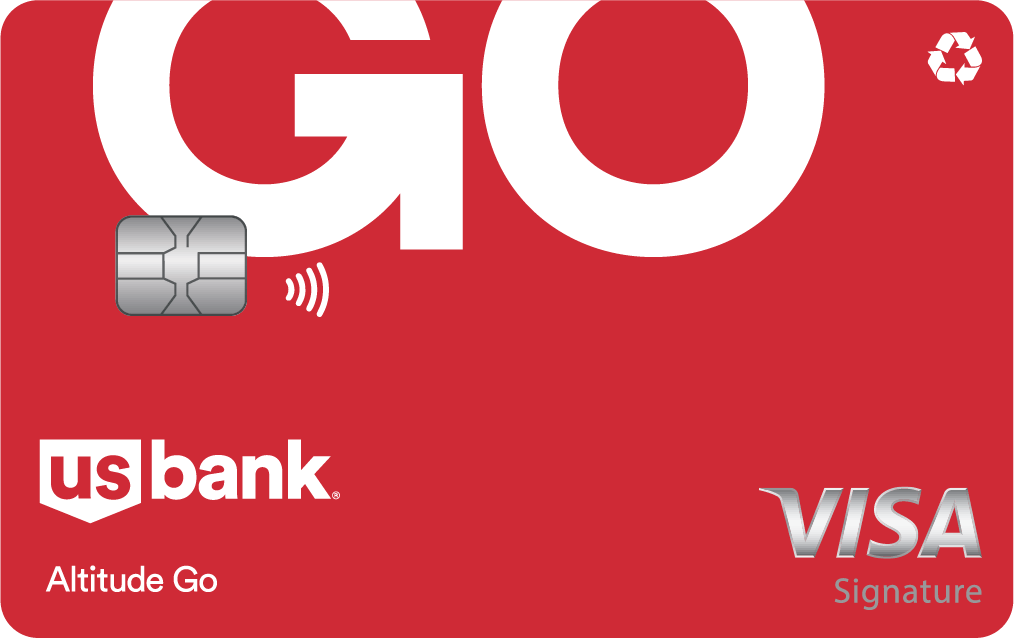This offer is no longer available on our site: U.S. Bank Altitude® Go Visa Signature® Card
When you pay with one of the best credit cards for restaurants, you can earn rewards whether you’re dining out, grabbing take-out or ordering delivery.
Here are our picks for the top five dining rewards credit cards.
| Card | Best for |
|---|---|
| American Express® Gold Card | Restaurant credits |
| Chase Sapphire Reserve® | DoorDash |
| American Express Platinum Card® | Uber Eats |
| Chase Freedom Unlimited® | Everyday cash back |
| U.S. Bank Altitude® Go Visa Signature® Card | A night in |
Best for restaurant credits: American Express® Gold Card
Here’s why: The American Express® Gold Card offers a lot of value in restaurant credits each year.
The card features up to $120 in dining statement credits, dished out as monthly statement credits of up to $10 when you order from a handful of places, like The Cheesecake Factory or through Grubhub (enrollment required). You’ll also get up to $10 in Uber Cash each month, which you can use by selecting your American Express card as the payment method on Uber Eats orders or Uber rides in the U.S.
Even if you don’t use the credits, you’ll earn four Membership Rewards® Points per $1 spent on dining purchases (on up to $50,000 per year, then earn one point per $1), including takeout and delivery services in the U.S. Purchases outside of bonus categories earn one point per $1 spent.
The big drawback is the card’s $325 annual fee. But it’s much easier to make the most of the card if you use the restaurant credits.
Here’s our full review of the American Express® Gold Card.
Best for DoorDash: Chase Sapphire Reserve®
Here’s why: The Chase Sapphire Reserve® features a complimentary DashPass subscription, which could make you eligible for free delivery on certain orders.
Beyond that, you’ll get three points for every $1 you spend on dining, which includes food delivery services. You’ll also earn a $300 annual travel credit, and after that, you’ll get four points for every $1 you spend on flights and hotels booked direct. You get one point per $1 spent on purchases outside of bonus categories.
But you’ll have to decide whether these rewards and other perks outweigh the $795 annual fee.
Learn more about the Chase Sapphire Reserve®.
Best for Uber Eats: American Express Platinum Card®
Here’s why: The American Express Platinum Card® features up to $200 in Uber Cash annually, which can be used on Uber Eats orders in addition to Uber rides when you add your card to your Uber account and select it as your payment method.
Of course, you’ll have to consider the Uber benefits in the larger context of the $895 annual fee.
With that in mind, it’s probably best for frequent travelers. You’ll get access to world-class airport lounges, and with enrollment you can get a $200 airline fee credit and complimentary elite status at Hilton and Marriott hotels.
You can earn five points for every $1 you spend on prepaid hotels and flights booked through American Express on amextravel.com or directly with the airlines — though there’s an annual earning cap of $500,000 spent on flight purchases. You’ll earn one point per $1 spent on all other purchases (and on flights after that cap kicks in).
For more information, check out our review of the American Express Platinum Card®.
Best for everyday cash back: Chase Freedom Unlimited®
Here’s why: The Chase Freedom Unlimited® gives you 3% back on dining, which includes restaurants, takeout and eligible delivery services.
But you’re not limited to food purchases with this card. You’ll also get …
- 5% back on travel bookings made through Chase Travel℠
- 3% at drugstores
- 3% on dining at restaurants, including takeout and eligible delivery services
- 1.5% on all other purchases
What’s more? The annual fee is $0.
Learn more about the Chase Freedom Unlimited®.
Best for a night in: U.S. Bank Altitude® Go Visa Signature® Card
Here’s why: The U.S. Bank Altitude® Go Visa Signature® Card is perfect for a relaxing night at home.
You’ll get four points for every $1 you spend on dining, which includes not only dining out at restaurants, but also ordering in for takeout or food delivery. You’ll also earn:
- Two points per $1 spent on grocery store purchases, on streaming services, and at gas stations and EV charging stations
- One point per $1 spent on all other eligible purchases
When you combine that with the $15 annual streaming credit, you have the makings of a great night in.
Another plus: The annual fee is $0.
Learn more about our picks for the best U.S. Bank credit cards.
How we picked these cards
Not all rewards or cash back cards offer bonus rewards on dining, so that was our first filter. Then, we narrowed down our picks by considering the annual fees, additional cardholder benefits and the value of the rewards.
How to make the most of dining rewards cards
A dining credit card should fit into your routine and offer valuable rewards when you dine out, but you don’t want to feel pressure to eat out more often. While family dinners and date nights might involve a restaurant, if you’re focused on saving money, buying groceries to cook at home is often the way to go.
With this in mind, consider how a card with an annual fee might affect your dining habits — particularly if the fee is several hundred dollars. If you think you might dine out more often than you’d like simply because you get 3% to 5% back in rewards, you may be better off with a card that offers a slightly lower rewards rate and no annual fee.
In either case, you can maximize your rewards by also registering your card with a dining rewards program. Once registered, you can earn points, miles or cash back at select restaurants by using your registered card to pay. Plus, you get these rewards in addition to your credit card rewards.
Calculate a tip
Whether you’re alone or out with friends, find out how much to tip with our handy tip calculator





